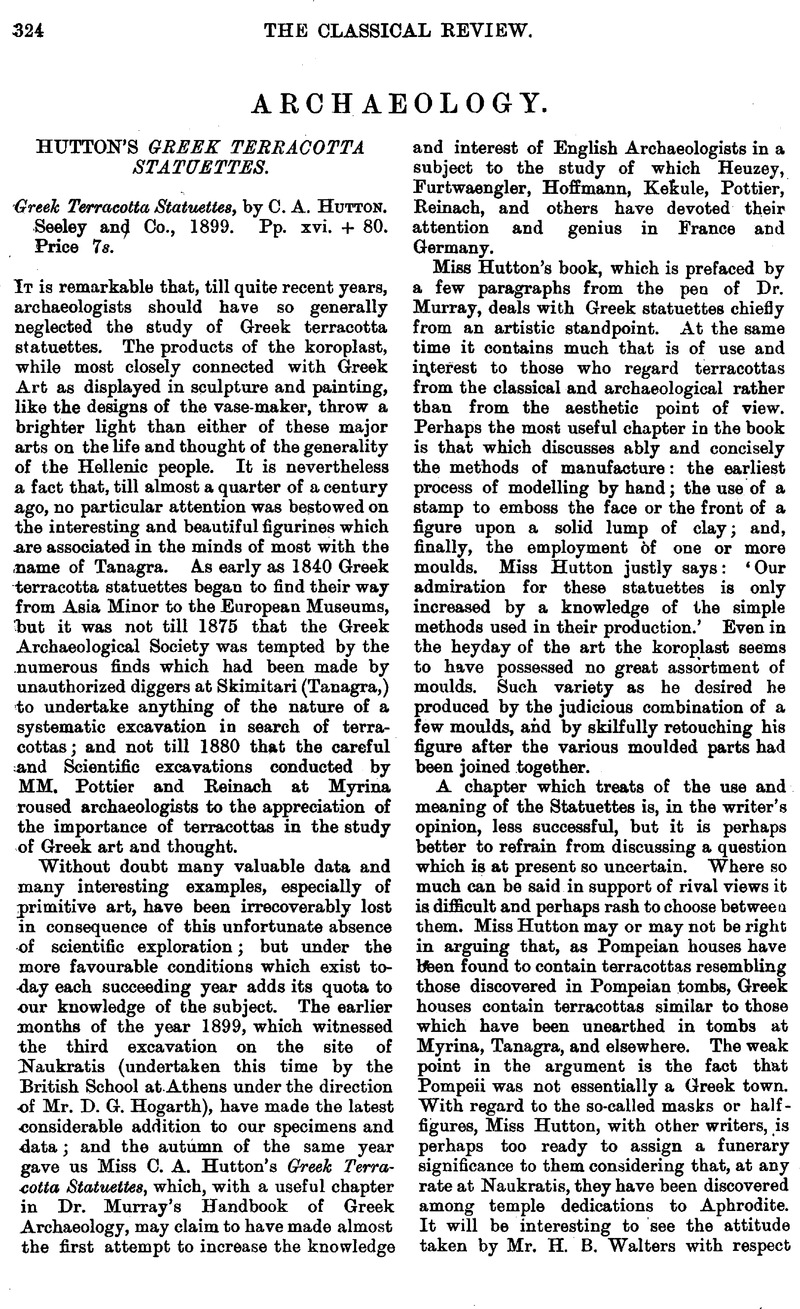No CrossRef data available.
Article contents
Archaeology
Published online by Cambridge University Press: 27 October 2009
Abstract

- Type
- Archaeology
- Information
- Copyright
- Copyright © The Classical Association 1900
References
page 325 note 1 An argument, perhaps, against the Egyptian origin of ‘oscilla’ asserted by Miss Hutton.
page 328 note 1 The Book of the Dun Cow, Lebar na huidre, published in facs. by the Royal Irish Academy, 1870.
page 329 note 1 Our store of Irish epic literature is rich and varied: much has been published and translated, and more still remains untouched. Facsimiles of the most important MS. collections have been published by the R. Ir. Acad., e.g. Book of Leinster, Book of Lecan; editions of texts with translations, notes, and discussions, may be seen in La Revue Celtique (Paris), Meyer, and Stern's, Zeitschrift für Celtische Philologie (Halle, Niemeyer; London, Nutt)CrossRefGoogle Scholar, and Windisch, and Stokes', Irische Texte, several series (Leipzig, Hirzel)Google Scholar. The following deal fully with an important branch of the Irish epic: The Cuchullin Saga (1898, Nutt), with an introduction by Miss Eleanor Hull, who acts as editor, and translations from the Irish by eminent Celtic scholars, The Feast of Bricriu [the ‘poison-tongued,’ the Irish Thersites], edited and translated by G. Henderson, M.A., Ph.D. (1900, Irish Texts Society). The most complete list of MSS. containing epic tales is d'Arbois de Jubainville's Essai d'un Catalogue de la Littérature épique de l'Irlande (Paris, Thorin, 1883)Google Scholar. To classical students the following short list of Irish versions of Greek and Latin classics, may be of some interest:—
The Odyssey.—Merugud Uilix (Book of Ballymote = B.B. end of 14th cent.), edited by Kuno Meyer. (Nutt.)
The Aeneid (B. B.).—Books I.–IV., edited with Eng. trans, by T. Hudson Williams in Zeitschrift für Celtische Philologie, II. Band, 3 Heft.
The Destruction of Troy (Dares Phrygius).—Numerous versions exist, e.g. Book of Leinster (12th cent.), B. B., Trin. Coll. H. 2, 17 (14th cent. ?), edited with Eng. trans, by Whitley Stokes in Irische Texte ii. 1. One of the many Welsh versions is published in Rhys and Evans's Red Book of Hergest (14th cent.), Vol. II. (Oxford, 1890).Google Scholar
The History of Alexander the Great (after Orosius).—In the Lebar Brecc (end 14th cent.) and B. B.; edited, with Germ, trans., by Kuno Meyer in Ir. Texte, ii. 2.
Lucan's Pharsalia.—Cath Catharda, in Stowe MS. No. 992 (14th or 15th cent.).
page 329 note 2 The contest for this ‘hero's-portion’ forms the subject of some of the most popular Irish romances; one of the most important is translated in Cours de Litt. Celt. v. pp. 80–148, and Henderson's Feast of Bricriu.
page 329 note 3 An interesting parallel to the story of the crow helping the Roman warrior is found in one of the Welsh Arthurian tales, Breudwyt Bonabwy, in which Owein, a knight of Arthur's company, has a flock of crows which fight for their master on seeing his standard raised. (Red Book, vol. i. pp. 153 sqq.).
page 329 note 4 Irish ār-chu, from, ār, battle, Welsh aer, Gaulish ver-agros, ⋯γρ⋯, and cu (genitive con), κ⋯ων.
page 329 note 5 ‘Smith's dog,’ the Irish Achilles, who got this name after having killed a fierce dog belonging to a smith; probably a trace of the Heracles-Cerberuslegend.
page 330 note 1 Traces of a similar custom may be seen in the Welsh Breudwyt Ronabwy (Red Book, i. p. 146), where it is the man who falls asleep on the skin of a yellow calf who sees the wonderful visions that give their name to the tale, Rhonabwy's Dream; cf. Lady of the Lake, Canto IV.
page 330 note 2 Cf. Achilles, son of a goddess, and his Celtic counter-type Cuchullin, son of the god Lug. There is a very striking resemblance between these two favourite heroes: both excel in bravery, the life of both is brilliant but cut off before its prime. The horse of Achilles possesses the gift of speech, can divine the future, and sheds tears over his master's fate: the horse of Cuchullin foresees coming events, and sheds tears of blood.
page 330 note 3 There is no need, adds our author, for modern editors to change Rheno into Brenno, as we know from inscriptions that the Rhine was worshipped, and a tradition existed that the Rhine was father to a mortal son by a mortal woman; Propertius' authority may have been Fabius Pictor, the contemporary of Virdomarus.
page 330 note 4 The Homeric Elysium. Mortals have also reached this happy land, as Bran mac Febal who, in the Irish legend, met on his way the sea-god Manannan mac Lir travelling in a chariot which gently rolled over the crest of the waves. See the Voyage of Bran (Nutt), edited and translated by Kuno Meyer with essay on the ‘Happy Other-world,’ by Alfred Nutt.
page 330 note 5 Diod. v. 28.
page 330 note 6 Mela, iii. c. 2, § 19.
page 331 note 1 Sometimes a hard bullet made of lime and the brain of a fallen enemy was used; cf. Cours de L. C. v. 366–373.
page 331 note 1 Berl. Phil. Woch. 9 June.
page 331 note 2 Notizie degli Scavi, Nov. 1899.
page 331 note 3 Notizie degli Scavi, Oct. 1899.
page 332 note 4 Athenaeum, 12 May.
page 332 note 5 Notizie degli Scavi, Dec. 1899.
page 332 note 6 Berl. Phil. Woch, 2 June.
page 333 note 7 Athenaeum, 19 May.
page 333 note 8 Berl. Phil. Woch. 28 April.


